In this article, we share with you, five of the best ‘Mix With The Masters’ production classes from Finneas, Sonny Digital, Emilie Haynie, Stargate and Young Guru.
‘Therefore I Am’ – Billie Eilish
Course Tutor: Finneas
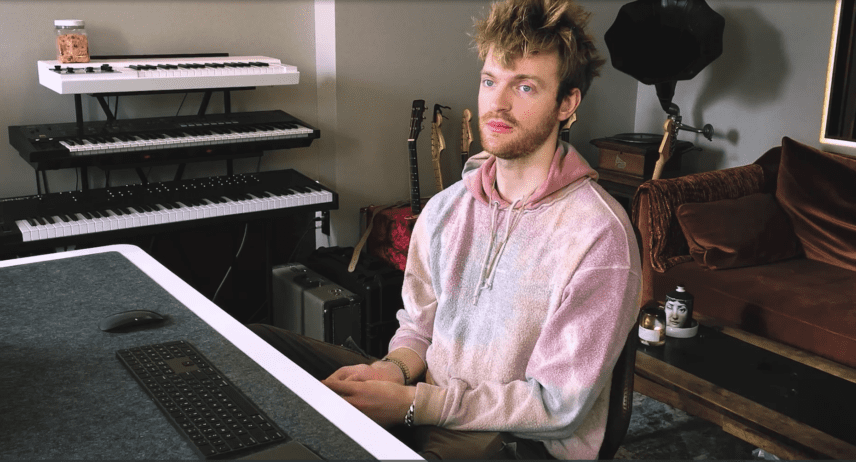
Class Description
Unless you’ve been living under a rock, Billie Eilish has become one of, if not, the biggest pop star of the last few years. What makes her story even more fascinating is her sound is in a large part crafted by her brother Finneas. Working typically in Logic Pro, the duo have crafted a unique pop sound that has won multiple awards and seen them working on the latest Bond movie.
The Mix With The Masters course is bound to get a tonne of traffic. But is it any good? Here are the key takeaways from 35 mins spent delving into the session for the hit singles ‘Therefore I Am’.
5 takeaways from watching Finneas’ course:
- Mixing on the go. This one’s a source of endless debate amongst producers. Finneas starts off by saying he does mix as he goes. He will take time to ensure every little sound is more or less as he wants it before moving on to his next idea. And once done he sends it to Rob Kinelski. That might not work for everyone but at 598 million plays it’s working for him.
- Plugin chains. This might go against the less is more adage but Finneas takes a very stock 808 and makes it into a Hans Zimmer monster with a cool chain. In Logic he uses Smp Delay > Clip Distortion > Valhalla reverb (yup!), > Channel EQ > Little Altar Boy. We’d guess most people are not grabbing a reverb or altar boy for the bass, especially an 808. Think outside the box (even if you stay producing within one.)
- Singalong. If you’ve not heard Therefore I Am then pop it on and hear how the bass line is eminently singable. Finneas says he learned this from Bad Guys which is that each track must have a musical element that’s singable. Sounds simple but it’s not. He also layers the bass with a zipper sound which is acting like a hi-hat. So there is no traditional hi-hat but rather a hi-hat working with the bass line. It’s all there to create magic. And while you’re at it, tweak the envelopes to bed your sound into the track. Get tweaking.
- Chord structures. Of course, working with world-class singers can help, but Billie Eilish really knows how to harmonise her lead vocal. It’s often surprising how people can struggle with this but the chord structure that Billie adds to what is essentially a simple, but catchy, beat brings this track to life. Using the voices as a production tool to play chords, essentially, can save you a lot of money on VSTs also. So if you’re struggling, either reach out to Billie or find a great local singer and stack those layers.
- Listen to yourself. Someone in Finneas position is around ‘experts’ day in and day out. But he does not accept he is a master and learned something a long time ago that if it sounds and feels good to you then it’s ready. His relationship with mixing is to let the math be done by pro’s but your role as producer is complete once it bangs.
‘After Party’ – Don Toliver
Course Tutor: Sonny Digital
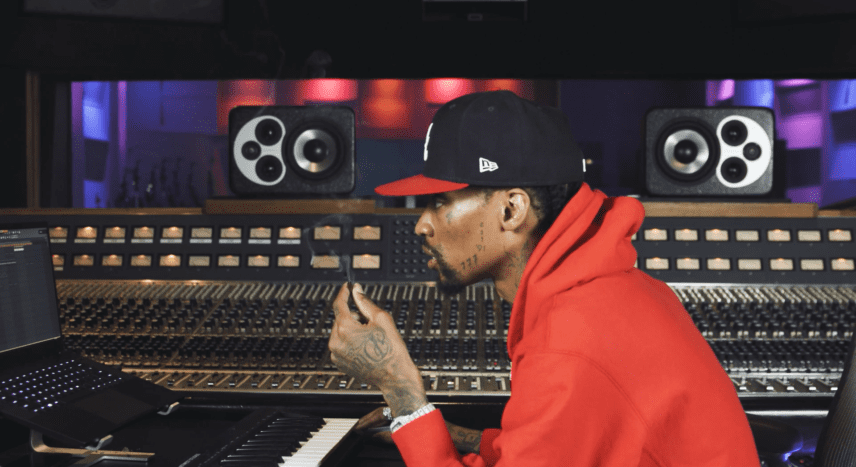
Class Description
Sonny Digital should be a name most people are familiar with. Sitting in EastWest Studios in Hollywood, a legendary destination, he takes us through how he made this beat. Sonny stands out on the list for being the only producer to successful smoke a blunt and hold it together in an interview.
5 takeaways from watching Sonny Digitals’ course:
- Less is more. Of course, this feels played out a gazillion times but it’s true. His experience, especially working with Travis Scott, is that the artist will always want to add something. So, make sure the bare bones absolutely bang and allow space for someone else to add their input. In short, if an artist can hear something they are going to add, there is a good chance they will want to take the beat. Good to know…!
- Sampling. Get creative. Stop dragging and dropping. At the end of the day, everyone has access to loads of samples thanks to Splice, Loopcloud etc. But if you are just dropping in, what chance do you have of making your own sound? Slice it, change the BPM, reverse it, convert it to MIDI and move the beats around – get creative. Just don’t drag and drop. You’ve been warned.
- More sampling. Think like a DJ. Merge two samples in the same key. Ignore the BPMs of the respective tracks just beatmatch them and make them work together. You’ll be surprised by the results. Think colours and merge colours to get something else. It wouldn’t be a hip-hop tutorial if we were not covering sampling in depth.
- Templates. If you want to work professionally then set yourself correctly. Sonny Digital makes beats between an MPC, Pro-Tools and FL Studio. He has everything set up for speed. Templates, shortcuts, connections, plugin chains – everything is ready to be able to deliver in the studio immediately. That might not be to everyone’s taste but people are leaning on him in the studio and he needs to make sure he’s ready. Be prepared.
- Layering one-shots. Typically Sonny Digital is layering one-shots and tweaking them. So, good samples stacked and then tweaking them. This can be moving them slightly on the grid, affecting the ADSR, different transients, turning them up fully before distorted, tuning and so on. Even find a drum loop and then adding his samples on top. Layering is good.
‘June’ – Florence and The Machine
Course Tutor: Emilie Haynie
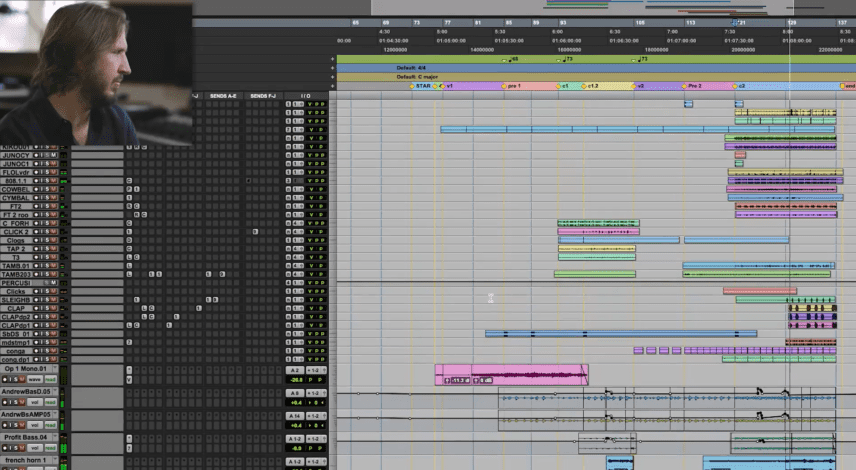
Class Description
Florence and the Machine are a pop band with a difference. They have captured the ears of millions but their sound is a sonic smorgasbord. They’re not sitting in typical patterns and textures. Call it cinematic pop if you will. Much of that is due to Emile Haynie who actually comes from a hip-hop background and whose history of sampling led him to new sonic discoveries.
Note: It’s an awesome studio…(again!)
5 takeaways from watching Emile Haynie’s course:
- Reverb. Reverb, especially with EQ, can really change the sound of a synth. You can make mellotrons sound like horns as Emile does in this track. Plenty of software with effective reverb can lead you to interesting results.
- Layering. Just as with nearly every course, it’s getting silly to keep repeating this but again layering is crucial to the sound of FATM. And again, layering but tweaking. A good example? Duplicate the piano and reverse the duplicate? Maybe then duplicate the reverse and cut it up in small bits to add accents in the space.
- More layering. Bear with us here. Yes less is generally more (again) but you’ll be blown away but how many drums are in this record. There is Florence Welch on percussion, claps, stomps a drummer and an MPC on top of that. That’s a lot of sounds. Apply this to electronic music and you might find you’re entering territory you wouldn’t have typically gone to. Without counting, there are probably 30 elements here in the percussion.
- Strings. Sample what you record. Don’t hit record and try to get a perfect take. And we’re not talking about comping either but just choose something for a different reason it was intended. And then use plugins – again reverb – lots of it. It really can change the texture.
- Telefunken 251. It’s come up so many times it’s worth thinking about if you wanna record vocals. If it’s out of budget then there are lots of good alternatives such as the Neumann 103. Also, Emile uses the SM 57 just in the room. Yes, you heard that right.
‘Diamonds’ – Rihanna
Course Tutor: Stargate
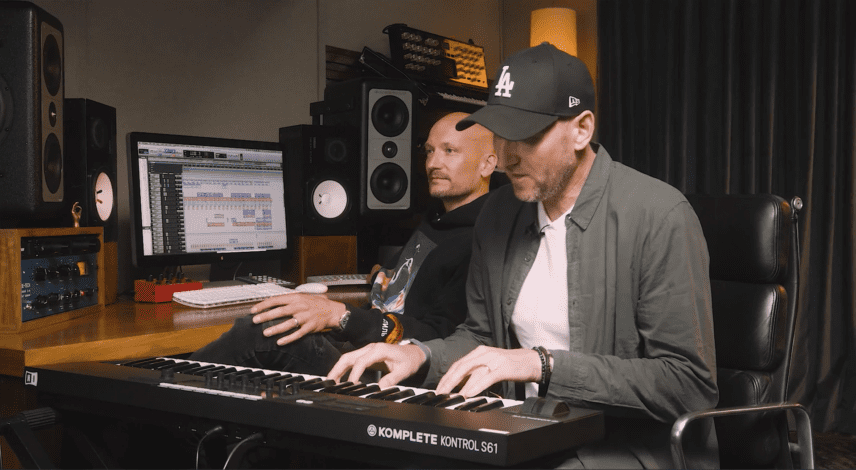
Class Description
A track that surely everyone knows, Diamonds is one of Riri’s biggest hits (from a vault of monster smashes). Stargate, the production duo behind it, and countless other huge pop anthems take us through how it was made and what we can learn.
Often we hear if you want to excel in something focus on it (such as techno if you just wish to produce techno). But the other school of thought is that it’s beneficial to learn from other disciplines. We dived in to see what nuggets we might use in electronic music from Rihanna.
5 takeaways from watching Stargate’s course:
- Voicings. A pop record might ‘sound’ simple but there’s more than you think. Voicings are imperative and can change the mood quickly. In this case, the last chord in bar 4 has a different voicing to the rest. Subtle but effective.
- Layering. We mention it again as it’s a takeaway every time and often for different reasons. Layers are crucial and it’s not just duplicating and tweak. Think what sounds might go together. Then get creative. If there is a bell, tune it or reverse it. Do something outside the box and you’ll find your layers start to take on a world of their own.
- Pitching strings. It might not be obvious, but why not pitch and echo strings? Sure, strings are considered natural organic instruments but play around. Echoboy, pitch, filter and some driving EQ can take strings to a whole new dimension and not sound like an orchestra.
- Bass. This was incredible. Bass harmonies AND two bass subs. The idea, here again, is more is more! But we’ve never heard of multiple sub-bass in one song and it’s certainly interesting. Also, having a track for bass harmonies will assist your bass line. They don’t delve into what, but our suggestion would be to try 3rd and 5ths first. Just go easy. We’d imagine this will take some getting used to.
- Don’t give up hope. You may like something and an artist doesn’t. And vice versa. Don’t beat yourself up. Writing camps can be stressful and fragile so just try to go with the flow and keep creative. And certainly, try to work with good top line writers. They will help your beats get placed.
‘Kudeta’ – Voli Contra
Course Tutor: Young Guru
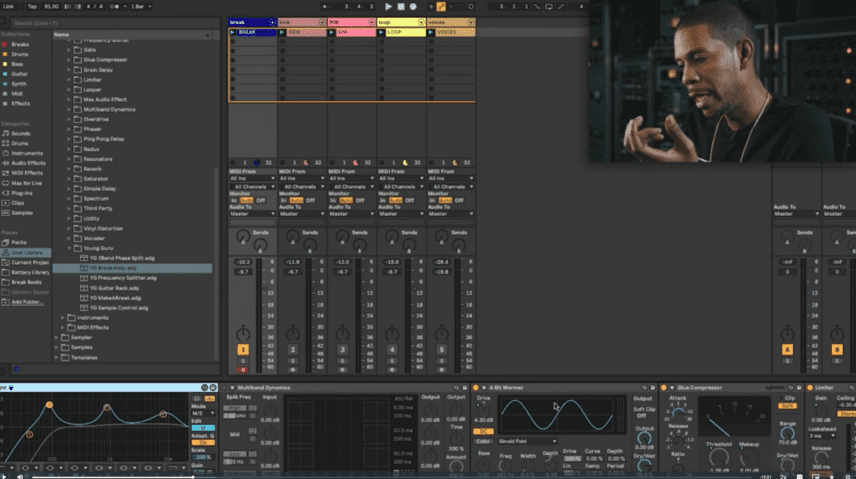
Class Description
This in-depth video series reveals key aspects of the production workflow and mix techniques of Jay-Z’s right-hand man, described by WSJ as “the most successful engineer in the history of hip-hop”.
Young Guru explains how he searches for sounds, samples them from records, and maps them to drum machines and controllers. He shares details of how he created the loop that sparked the process of building an entire track for the artist Voli Contra. Using an Akai MPC and Ableton Push integrated with Live, he demonstrates a number of approaches and features that are essential to his beat-making process. After a deep dive into the Ableton Live production session, Young Guru opens the Pro Tools mix session to show you how he refined the parts to finish the record!
5 takeaways from watching Young Guru’s course:
- A word about DAWS. Is this rule-breaking? Young Guru uses a tonne of different software. Most producers only use one, at most two and maybe hardware. But to jump around several DAWs for one track and beat machines is untypical but hey, it’s working for him. Is it time to step back from Ableton?
- Workflow. Leading on from the above the big takeaway from Young Guru is workflow. This guy has his workflow down and it means he can really be free to achieve what he wants. I.E after making on the MPC studio he then uses the Push 2 to arrange. Not customary but kinda cool.
- Crazy EQ. Again on workflow, it’s lovely to see Young Guru extol the benefits of Ableton Live Racks. They are numerous, and too much for this article, but what stood out is his intense EQ’ing. That’s not playing by the rules and we salute him for it.
- Auditioning in context. Assigning 120 kicks to a pad and then listening to them one at a time. Again powerful rack selectors can make your sound selection far easier.
- Swinging hi-hats. The way Young Guru does hi-hats is definitely different to most. He thinks of them as positions where he uses note movement rather than groove. It’s hard to describe without watching so hit the link and check it out. Sure, many producers will move MIDI notes slightly on the grid, but his method is different to that.
